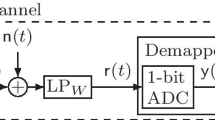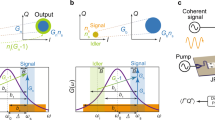Abstract
Physical limits on the amount of information carried by bandlimited waveforms radiated in one and three dimensions are considered. It is shown that the entropy of radiation can achieve the Bekenstein bound using a “burst” of energy, whose density vanishes as the radiating system expands. In comparison, black body radiation of infinite bandwidth achieves the same entropy scaling, that is proportional to the volume of the space, but requires an energy density that remains constant as the system expands. Rather than following the standard statistical physics approach of counting the number of eigenstates of the Hamiltonian of the quantum wave field, our derivation first considers an optimal subspace approximation, and then determines the number of bits that are required to represent any waveform in the space spanned by this representation with a minimum quantized energy error. This favors a geometric interpretation where the complexity of state counting is replaced by the one of determining the minimum cardinality covering of the signal space by high-dimensional balls, or boxes, whose size is lower bounded by quantum constraints. All derivations are given for both deterministic and stochastic settings.




Similar content being viewed by others
References
Bekenstein, J.D.: Universal upper bound on the entropy-to-energy ratio for bounded systems. Phys. Rev. D 23(2), 287–298 (1981)
Bekenstein, J.D.: Entropy content and information flow in systems with limited energy. Phys. Rev. D 30(8), 1669–1679 (1984)
Bekenstein, J.D.: Communication and energy. Phys. Rev. A 37(9), 3437–3449 (1988)
Bekenstein, J.D., Schiffer, M.: Quantum limitations on the storage and transmission of information. Int. J. Mod. Phys. C 1(4), 355–422 (1990)
Schiffer, M.: Quantum limit for information transmission. Phys. Rev. A 43(10), 5337–5343 (1991)
Bekenstein, J.D.: Energy cost of information transfer. Phys. Rev. Lett. 46(10), 623–626 (1981)
Bremermann, H.J.: Quantum noise and information. In: LeCam, L.M., Neyman, J. (eds.). Proceedings of the Fifth Berkeley Symposium on Mathematical Statistics and Probability. University of California Press, Berkeley (1967)
Bremermann, H.J.: Minimum energy requirements of information transfer and computing. Int. J. Theor. Phys. 21(3–4), 203–217 (1982)
Caves, C.M., Drummond, P.D.: Quantum limits on Bosonic communication rates. Rev. Mod. Phys. 66(2), 481–537 (1994)
Lebedev, D.S., Levitin, L.B.: Information transmission by electromagnetic field. Inf. Control 9, 1–22 (1966)
Bowen, J.: On the capacity of a noiseless photon channel. IEEE Trans. Inform. Theory 13(2), 230–236 (1967)
Gordon, J.P.: Quantum effects in communication systems. Proc. IRE 50(9), 1898–1908 (1962)
Stern, T.E.: Some quantum effects in information channels. IEEE Trans. Inform. Theory 6, 435–440 (1960)
Pendry, J.B.: Quantum limits to the flow of information and entropy. J. Phys. A Math. Gen. 16, 2161–2171 (1983)
Yuen, H., Ozawa, M.: Ultimate information carrying limit of quantum systems. Phys. Rev. Lett. 70(4), 363–366 (1992)
Lachmann, M., Newman, M.E., Moore, C.: The physical limits of communication or why any sufficiently advanced technology is indistinguishable from noise. Am. J. Phys. 72(10), 1290–1293 (2004)
Bucci, O., Franceschetti, G.: On the spatial bandwidth of scattered fields. IEEE Trans. Antennas Propag. 35(12), 1445–1455 (1987)
Bucci, O., Franceschetti, G.: On the degrees of freedom of scattered fields. IEEE Trans. Antennas Propag. 37(7), 918–926 (1989)
Pinkus, A.: \(n\)-Widths in Approximation Theory. Springer, New York (1985)
Franceschetti, M.: On Landau’s eigenvalue theorem and information cut-sets. IEEE Trans. Inform. Theory 61(9), 5042–5051 (2015)
Lim, T.J., Franceschetti, M.: Information without rolling dice. IEEE Trans. Inform. Theory 63(3), 1349–1363 (2017)
Merhav, N.: Statistical physics and information theory. Found. Trends Commun. Inform. Theory 6(1–2), 1–212 (2009)
Donoho, D.L.: Wald lecture I: counting bits with Shannon and Kolmogorov. Technical Report, Stanford University (2000)
Bekenstein, J.D.: How does the entropy/information bound work? Found. Phys. 35, 1805–1823 (2005)
Bousso, R.: Bound states and the Bekenstein bound. arXiv:hep-th/0310148
Casini, H.: Relative entropy and the Bekenstein bound. Class. Quantum Gravity 25(20), 205021 (2008)
Pesci, A.: A proof of the Bekenstein bound for any strength of gravity through holography. Class. Quantum Gravity 27(16), 165006 (2010)
Gallager, R.G.: Information Theory and Reliable Communication. Wiley, New York (1968)
Cover, T.M., Thomas, J.: Elements of Information Theory, 2nd edn. Wiley, New York (2006)
Landau, H.J., Widom, H.: The eigenvalue distribution of time and frequency limiting. J. Math. Anal. Appl. 77, 469–481 (1980)
Landau, H.J.: On Szegö’s eigenvalue distribution theorem and non-Hermitian kernels. J. Anal. Math. 28, 335–357 (1975)
Author information
Authors and Affiliations
Corresponding author
Appendix
Appendix
The computation of the entropy of a continuous random variable quantized at fixed resolution is standard [29]. Here, we adapt this computation to a quantized resolution that grows sub-linearly, as indicated in Fig. 2. Consider a positive random variable \({{\mathrm{\mathsf {A}}}}\) distributed according to a continuous density g(a). By continuity, for all k we let a(k) be a value such that
The quantized random variable \({{\mathrm{\mathsf {A}}}}^{\sigma }\) is defined as
We compute the Shannon entropy
For small values of \(\sigma \), the first term approaches a Riemann integral that coincides with the differential entropy of \(\mathsf {A}\), and we have
It now follows that by drawing \(N_0\) independent zero mean Gaussian random variables of variance P, the entropy of the quantized sequence is, for small values of \(\sigma \), approximated by
Rights and permissions
About this article
Cite this article
Franceschetti, M. Quantum Limits on the Entropy of Bandlimited Radiation. J Stat Phys 169, 374–394 (2017). https://doi.org/10.1007/s10955-017-1867-y
Received:
Accepted:
Published:
Issue Date:
DOI: https://doi.org/10.1007/s10955-017-1867-y




